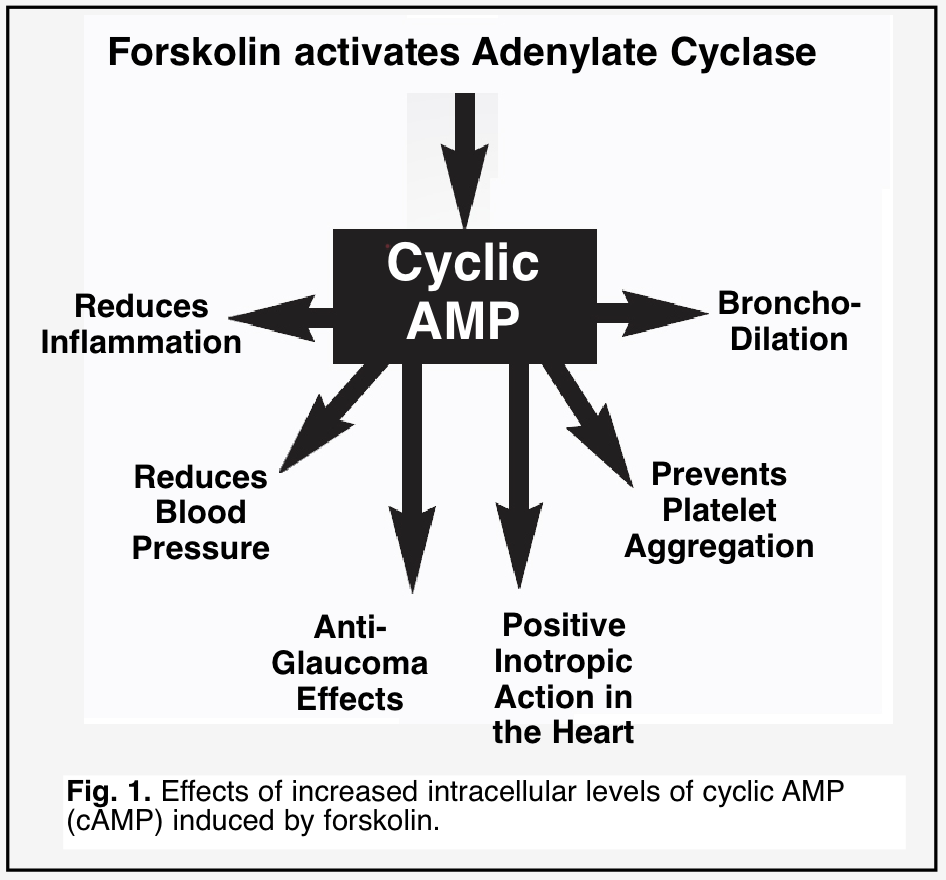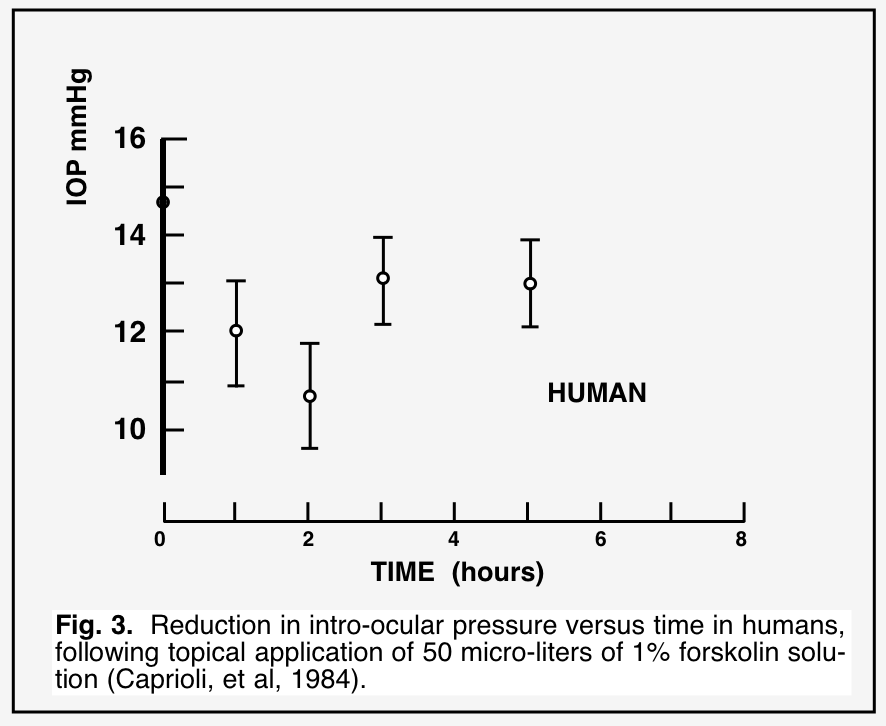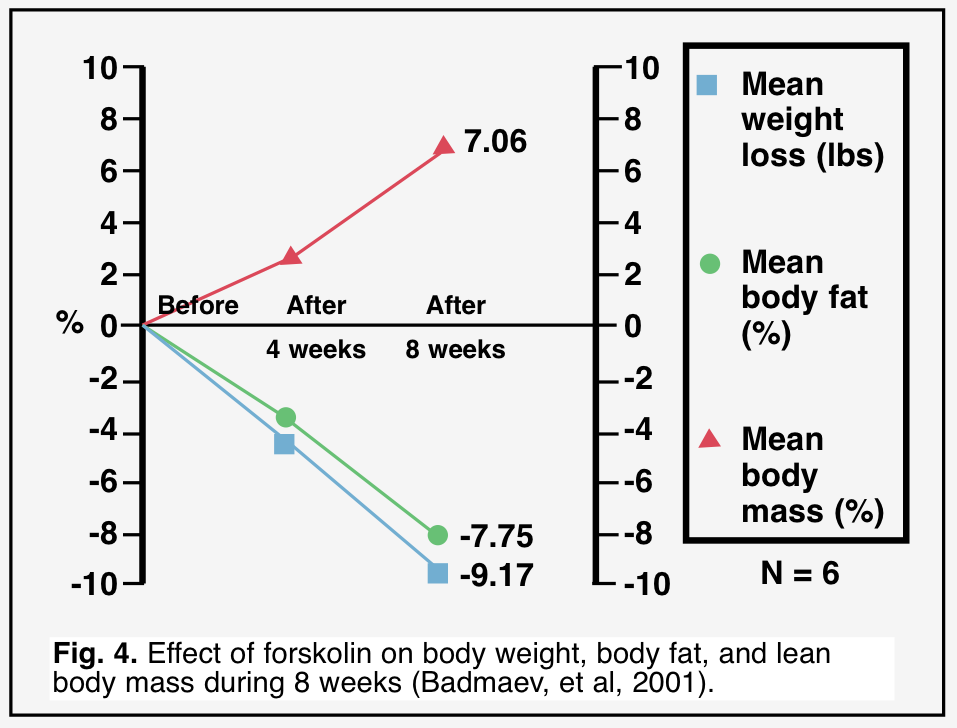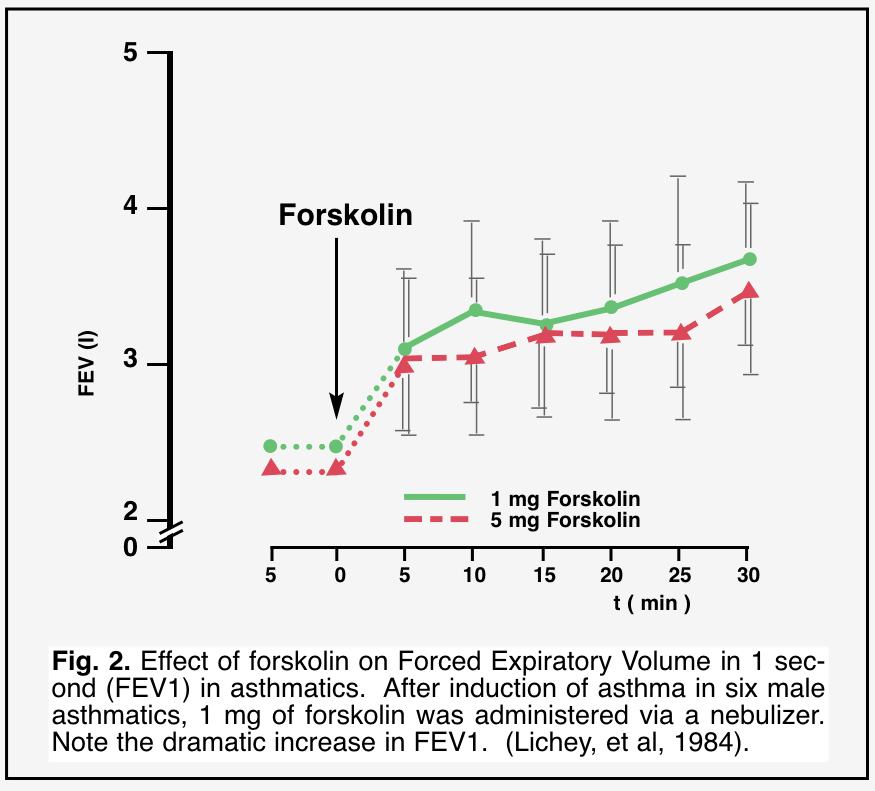Forskolin is an extract from the plant, Coleus forskohli. Coleus has been traditionally used in Ayurvedic medicine for a variety of conditions, including hypertension, asthma, eczema, psoriasis, congestive heart failure, and angina. The effects of forskolin have been intensively researched in in vitro, animal, and human clinical studies.
Mechanism(s) of Action
Forskolin acts primarily by activating the enzyme adenylate cyclase, which results in increased cyclic adenosine monophosphate (cAMP) in cells. Cyclic AMP belongs to a class of substances known as “second messengers,” and is one of the most important cell-regulating compounds. Among its many roles, cAMP activates numerous other enzymes involved in diverse cellular functions. Hormones and neurotransmitters also activate adenylate cyclase – but forskolin appears to be able to activate adenylate cyclase by itself. Thus, forskolin can increase cyclic AMP without the assistance of hormones or neurotransmitters.
Effects of Cyclic AMP
Increased cellular cyclic AMP results in a broad range of physiological and biochemical effects, including inhibition of platelet activation (resulting in decreased likelihood of blood clots), reduced release of histamine (resulting in decreased allergy symptoms), increased force of contraction of the heart, relaxation of the arteries and other smooth muscles, increased thyroid function, and increased lipolysis (fat burning) (Fig. 1).

A number of diseases are characterized, in part, by decreased intracellular levels of cyclic AMP. These include: asthma, eczema, psoriasis, angina, obesity and hypertension. In addition to its adenylyl cyclase-stimulating actions, forskolin also appears to have actions that are not due to this mechanism, but are due to its ability to alter a number of membrane transport proteins.1
Asthma and Allergies
Many drugs used to treat asthma and allergies are designed to increase cAMP levels. Usually they inhibit the enzyme (phosphodiesterase) that breaks down cAMP. This mechanism is the “flip side” of forskolin’s, which acts directly to increase cAMP. Thus, forskolin can be used by itself, or in addition to phosphodiesterase-inhibiting drugs in the prevention and treatment of many allergic conditions, including asthma.
Forskolin is an effective smooth muscle relaxer, resulting in bronchodilation, decreased airway resistance, and increased vital capacity and forced expiratory volume (important indicators of pulmonary function) (Fig 2). Forskolin also has tremendous anti-spasmodic action on various smooth muscles in the body, making it useful to relieve intestinal colic, uterine cramps, painful urination, angina, and hypertension.
 Cardiovascular Effects of Forskolin
Cardiovascular Effects of Forskolin
Coleus forskohli has traditionally been used to treat hypertension, congestive heart failure, and angina. Treating these conditions may be among the most useful uses for forskolin. Forskolin’s basic cardiovascular action is to lower blood pressure, while simultaneously increasing the contractility of the heart. This is believed to be due to forskolin’s cAMP-elevating ability, which results in relaxation of the arteries, and increased force of contraction of the heart muscle. One study involved seven patients with dilated cardiomyopathy—a particularly difficult condition to treat. Forskolin administration dramatically improved left ventricular function and overall cardiovascular performance.
Forskolin also increases cerebral blood flow, indicating that it may be beneficial in cerebral vascular insufficiency, and in enhancing post-stroke recovery. The platelet aggregation-inhibiting effects of forskolin also add to its value in cardiovascular disorders.
Glaucoma and Increased Intraocular Pressure
Glaucoma is a cause of visual loss characterized by nerve damage (usually associated with increased intraocular pressure), loss of visual field, glare, and sometimes pain. It is one of the leading causes of blindness in the elderly. Unfortunately, there is very little in the armamentarium of alternative health care practitioners that is effective in preventing or treating this poorly understood condition. However, a number of studies have shown that topical application of one percent forskolin eye drops resulted in significant decreases in intraocular pressure for up to five hours (Fig. 3).
 Researchers believe that it is the cAMP-elevating effects of forskolin that result in this significant improvement. Unfortunately, no commercial forskolin eye drops have been developed at this time. Although clinical experience is limited, oral forskolin appears to offer significant potential for sufferers of glaucoma or intraocular hypertension, and may be a major advance in the non-drug treatment of this condition.
Researchers believe that it is the cAMP-elevating effects of forskolin that result in this significant improvement. Unfortunately, no commercial forskolin eye drops have been developed at this time. Although clinical experience is limited, oral forskolin appears to offer significant potential for sufferers of glaucoma or intraocular hypertension, and may be a major advance in the non-drug treatment of this condition.
Psoriasis
Psoriasis is characterized by a relative decrease in cAMP compared to another second messenger, cyclic guanine monophosphate (cGMP). This imbalance results in a tremendous increase in cell division. In psoriasis, cells divide about 1,000 times faster than normal. Forskolin helps to alleviate psoriasis by normalizing the cAMP /cGMP ratio. (It should be noted that Fumaric Acid, by itself, is highly effective in the prevention and treatment of psoriasis. However, forskolin and Evening Primrose Oil may both be considered as additional substances to be added to a regimen to treat this particularly vexatious disease.)
Depression
Depression is believed to be due to an imbalance of neurotransmitters in the brain — most commonly either serotonergic (inhibitory) or dopaminergic (stimulatory). The response to various antidepressants depends on which neurotransmitter system has deviated farthest from the “norm.” If the serotonergic neurotransmitters are most deficient, serotonin precursors like 5-HTP or L-tryptophan, or the selective serotonin reuptake inhibitors (SSRI) like Paxil, Prozac, or Zoloft are most likely to be of help. If the dopaminergic (i.e., catecholamines like epinephrine or noradrenaline) neurotransmitters are deficient, catecholamine precursors like the amino acids L-Phenylalanine or L-Tyrosine, or monoamine oxidase inhibitors like GeroVital (GH3) or Deprenyl are most likely to help.
German scientists have been working with a different approach to elevating catecholamines, using a class of drugs that stimulate both the presynaptic as well as the postsynaptic components of catecholamanergic transmission. This novel approach uses a drug, rolipram, which acts by increasing cAMP (an action similar to that of forskolin), and inhibiting phosphodiesterase.
Although the researchers stopped short of recommending forskolin for the treatment of depression, they stated clearly that “elevated brain cAMP levels are closely linked to antidepressant activity in animal models of depression.”
Weight Loss
In vitro studies show that forskolin stimulates lipolysis (breaking down of fats) in fat cells. Additionally, scientists at the Penn State University College of Medicine have found that many obese people have lower than normal cAMP production. Based on these findings and in vitro studies, scientists theorized that forskolin might be an effective weight loss agent, especially for those with impaired cAMP production. A recent small study appeared to confirm this conjecture.
 Six overweight women took 25 mg of forskolin (250 mg capsules of 10% standardized forskolin extract) twice daily for eight weeks. At the end of the eight-week trial, the participants lost a mean of ten pounds, and reduced their percentage of body fat by nearly 8% (Fig. 4). Blood pressure levels also trended lower during the trial. These preliminary results indicate that forskolin may be a safe, useful adjunct to losing weight and maintaining normal body composition.
Six overweight women took 25 mg of forskolin (250 mg capsules of 10% standardized forskolin extract) twice daily for eight weeks. At the end of the eight-week trial, the participants lost a mean of ten pounds, and reduced their percentage of body fat by nearly 8% (Fig. 4). Blood pressure levels also trended lower during the trial. These preliminary results indicate that forskolin may be a safe, useful adjunct to losing weight and maintaining normal body composition.
Hypothyroidism
Forskolin also has demonstrated the ability to increase thyroid hormone production and stimulate thyroid hormone release. This mechanism of stimulating the thyroid to enhance metabolism may be one way in which forskolin promotes normal body weight. Forskolin’s effects in normalizing thyroid function may also contribute to its antidepressant effects, as depression is a common feature of hypothyroidism.
Cancer Metastases
Scientists at Brown University confirmed that forskolin is a potent inhibitor of platelet aggregation, as well as being a potent inhibitor of tumor colonization in mice. They suggested that forskolin could find a place in the prevention of tumor metastases.
Immune Enhancement
Forskolin also exhibits potent immune system enhancement by activating macrophages and lymphocytes.
Dosage
Based on the human studies for weight loss, 50 to 100 mg of forskolin taken in divided doses during the day appears to be a safe, effective dose for the conditions discussed above.
Reference
1. Agarwal, K.C., and Parks, R.E. Forskolin: A potential antimetastatic agent. Int J Cancer, 1983, 32: 801-804.
2. Allen, D.O., Ahmed, B., and Naseer, K. Relationships between cyclic AMP levels and lipolysis in fat cells after isoproterenol and forskolin stimulation, J Pharmacol and Exp Therapeutics, 1986, 238: 2, 659-238.
3. Badmaev, V., Majeed, M., Conte, A., and Parker, J. Diterpene Forskolin: A possible new compound for reduction of body weight by increasing lean body mass. Townsend Letter for Doctors and Patients, 2001, June, 115.
4. Bartels, S.P., Lee, S.R., and Nuefeld, A.H. Forskolin stimulates cyclic AMP synthesis, lowers intraocular pressure and increases outflow facility in rabbits, Current Eye Research, 1983, 2: 10, 673-681)
5. Caprioli, J., and Sears, M. Forskolin lowers intraocular pressure in rabbits, monkeys and man. The Lancet, 1983, April 30, 958-960.
6. Haye, B. Chronic and acute effects of forskolin on isolated thyroid cell metabolism Mol Cell Endocrinol, 1990, 43: 41-50.
7. Kramer, W. Effects of forskolin on left ventricular function in dilated cardiomyopathy. Arzneim Forsch, 1987, 37: 364-367.
8. Kreutner, W. Bronchodilatory and antiallergy activity of forskolin. European J Pharmacology, 1985, 111: 1-8.
9. Laurenza, A., Sutkowski, E.M., and Seamon, K.B. Forskolin: A specific stimulator of adenylyl cyclase or a diterpene with multiple sites of action? TIPS, 1989, November, 101: 442-446.
10. Lichey, J., Friedrich, T., Priesnitz, M., et al. Effect of forskolin on methacholine-induced bronchoconstriction in extrinsic asthmatics. The Lancet, 1984, July 21, 167.
11. Martin, L.F., Klim, C.M., Vannucci, S.J., et al. Alterations in adipocyte adenylate cyclase activity in morbidly obese and formerly morbidly obese humans. Surgery, 1990, 108: 228-235.
12. Okuda, H., Morimoto, C., and Tsujita, T. Relationship between cyclic AMP production and lipolysis induced by forskolin in rat fat cells. J Lipid Research, 1992, 33: 225-231.
13. Roger, P.P., Servais, P., and Dumont, J.E. Regulation of dog thyroid epithelial cell cycle by forskolin, and adenylate cyclase activator. Exp Cell Res, 1990, 172: 282-292.
14. Saunier, B. Cyclic AMP regulation of Gs protein. Thyrotropin and forskolin increase the quantity of stimulatory guanine nucleotide-binding proteins in cultured thyroid follicles. J Biol Chem, 1990. 265: 19942-6.
15. Schorlemmer, H.U. Forskolin for immune stimulation. Chem Abstr, 1985, 102: 1009.
16. Wachtel, H., and Loschmann, P.-A. Effects of forskolin and cyclic nucleotides in animal models predictive of antidepressant activity: interactions with rolipram. Psychopharmacology, 1986, 90: 430-435.
17. Wysham, D.G., Brotherton, A.F., and Heistad, D.D. Effects of forskolin on cerebral blood flow: Implications for a role of adenylate cyclase. Stroke, 1986, 17: 1299-1303.











 Cardiovascular Effects of Forskolin
Cardiovascular Effects of Forskolin
[…] https://nutritionreview.org/2014/05/forskolin-and-camp-wide-ranging-benefits-from-ayurvedic-herb/ […]